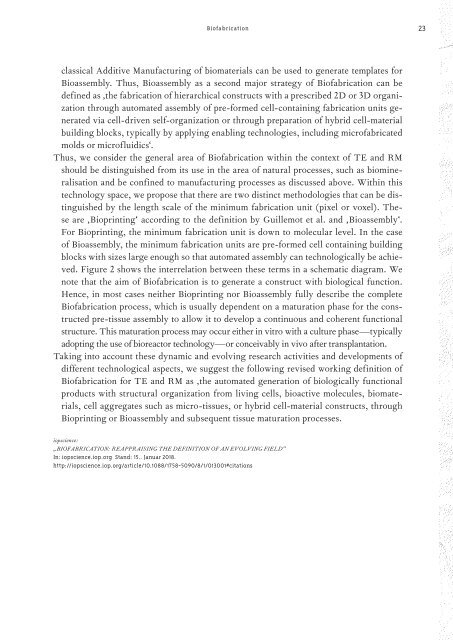Logbuch_17x24Druck_einzelseiten
You also want an ePaper? Increase the reach of your titles
YUMPU automatically turns print PDFs into web optimized ePapers that Google loves.
Biofabrication<br />
23<br />
classical Additive Manufacturing of biomaterials can be used to generate templates for<br />
Bioassembly. Thus, Bioassembly as a second major strategy of Biofabrication can be<br />
defined as ‚the fabrication of hierarchical constructs with a prescribed 2D or 3D organization<br />
through automated assembly of pre-formed cell-containing fabrication units generated<br />
via cell-driven self-organization or through preparation of hybrid cell-material<br />
building blocks, typically by applying enabling technologies, including microfabricated<br />
molds or microfluidics‘.<br />
Thus, we consider the general area of Biofabrication within the context of TE and RM<br />
should be distinguished from its use in the area of natural processes, such as biomineralisation<br />
and be confined to manufacturing processes as discussed above. Within this<br />
technology space, we propose that there are two distinct methodologies that can be distinguished<br />
by the length scale of the minimum fabrication unit (pixel or voxel). These<br />
are ‚Bioprinting‘ according to the definition by Guillemot et al. and ‚Bioassembly‘.<br />
For Bioprinting, the minimum fabrication unit is down to molecular level. In the case<br />
of Bioassembly, the minimum fabrication units are pre-formed cell containing building<br />
blocks with sizes large enough so that automated assembly can technologically be achieved.<br />
Figure 2 shows the interrelation between these terms in a schematic diagram. We<br />
note that the aim of Biofabrication is to generate a construct with biological function.<br />
Hence, in most cases neither Bioprinting nor Bioassembly fully describe the complete<br />
Biofabrication process, which is usually dependent on a maturation phase for the constructed<br />
pre-tissue assembly to allow it to develop a continuous and coherent functional<br />
structure. This maturation process may occur either in vitro with a culture phase—typically<br />
adopting the use of bioreactor technology—or conceivably in vivo after transplantation.<br />
Taking into account these dynamic and evolving research activities and developments of<br />
different technological aspects, we suggest the following revised working definition of<br />
Biofabrication for TE and RM as ‚the automated generation of biologically functional<br />
products with structural organization from living cells, bioactive molecules, biomaterials,<br />
cell aggregates such as micro-tissues, or hybrid cell-material constructs, through<br />
Bioprinting or Bioassembly and subsequent tissue maturation processes.<br />
iopscience:<br />
„BIOFABRICATION: REAPPRAISING THE DEFINITION OF AN EVOLVING FIELD“<br />
In: iopscience.iop.org Stand: 15.. Januar 2018.<br />
http://iopscience.iop.org/article/10.1088/1758-5090/8/1/013001#citations


